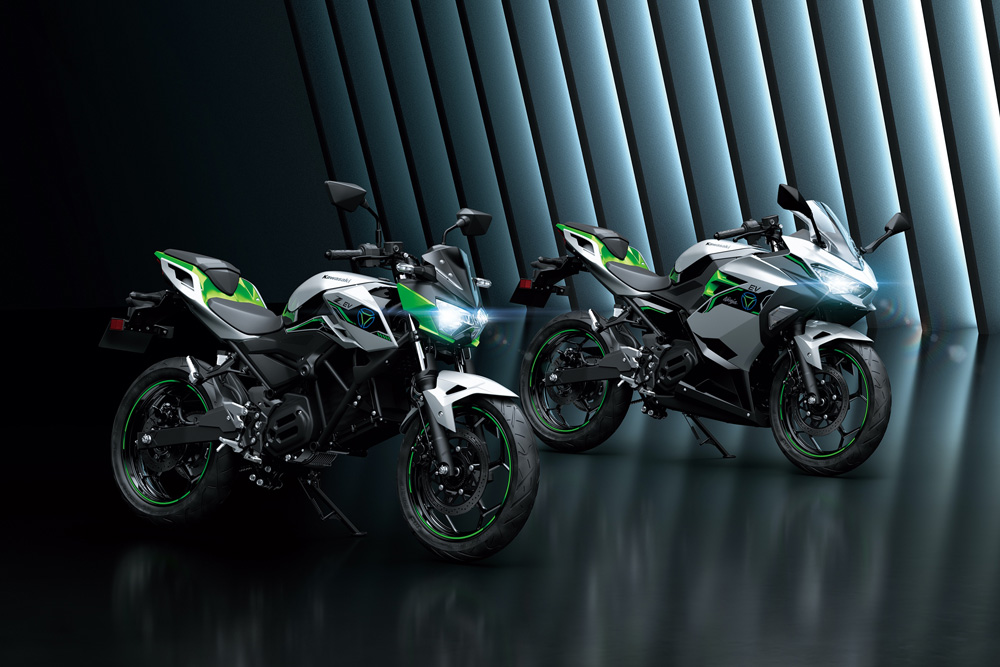Rennie Scaysbrook | August 9, 2023
Cycle News Lowside
COLUMN
Japan Is Coming (With An Electric Bike)
It’s about time, Japan is finally throwing its hat into the extremely small electric bike market, with news coming from my homeland in Australia that the Ninja e-1 and Z e-1 will be production models in the very near future.
 Japan is finally joining the electric bike race with the Kawasaki Ninja e-1 and Z e-1.
Japan is finally joining the electric bike race with the Kawasaki Ninja e-1 and Z e-1.
I say “very near” because we don’t have official confirmation as to when they will land in America and go on sale, but they will be here, that’s a certainty.
What’s interesting about the Kawasakis is that they are firmly aimed at new riders. Thanks to the eagle-eyed Dennis Chung at motorcycle.com, we know the Australian models will only have about 12 horsepower. I know, I know. 12 horsepower is basically nothing, and, crucially, we don’t know what torque output the e-1 platform will produce.
However, what is important is Kawasaki is actually building an electric bike for sale. Yamaha has teased the PES1 for God knows how long, and I won’t be expecting this to hit dealer floors any time soon. The fact that Kawasaki is going to firmly beat Honda to the punch to be the first of the Japanese Big Four (Honda, Yamaha, Suzuki, Kawasaki) to build a production electric bike is a score I’m certain is not lost on the Kawasaki Heavy Industries board.
I’ve been on the electric bandwagon for a while now because, like it or not, they are going to comprise a large part of our motorcycling future. The continual crapshoot that’s happening in the UK where, currently, the sale of petrol-powered motorcycles is due to end in 2035, means manufacturers have been keeping a watching brief as to future product development, and what happens there will also have an effect on the sale of such bikes here.
Alternative fuel sources are being studied at a major rate of knots, but more than likely, electric motorcycles will be sold increasingly alongside whatever petrol counterparts are legal at the time.
The electric space has been largely neglected by the major manufacturers with only American manufacturers Zero Motorcycles and Harley-Davidson showing any real sign of interest despite governments around the world slowly but surely putting the squeeze on internal combustion engines and their development.
Electric motorcycles are without question the most polarizing subject in modern motorcycling. Talk to anyone with a love of petrol (which I can guess is most of us), and sparky bikes represent the two-wheeled incarnation of the devil. No noise, no gearbox, no fun. Almost no one is buying them, but these feelings slowly get changed once you’ve spent a few hours on board one.
As commuter machines, they make perfect sense. Quick journeys with charging points at either end mean the only time you’ll see a gas station is for a Coke and tire pump up. My good friend Heath Cofran, the man who has clothed me for the past nine years at Alpinestars, is firmly on the electric train after purchasing a Zero SR/S a year or so ago. With a claimed 140 lb-ft of immediate torque, drag racing from the lights has never been so much fun.
The big issue with electric has always been range and charging. Again, if you’re using them as a commuter fodder, they make perfect sense (so long as you can disregard the often-exorbitant price of entry into the space). A few years ago, I had a Harley-Davidson LiveWire—now just called a LiveWire—and while the riding experience was surprisingly fun with all that torque, not being able to use a Level 3 charging station was an issue that I’m sure must weigh on potential buyers’ minds. I’d hope the Kawasaki electric bikes come with the ability to access Level 3, because if these bikes are aimed at predominantly new riders, making it easy for them to charge up and keep riding in any situation should be a priority.
I don’t think the lack of emissions from an electric vehicle has much to do with any potential purchase. Motorcycles contribute very little in terms of whether polar bear habitats sink into the ocean or not, but I guess having that little green tick on the shoulder is something owners can be proud of.
Kawasaki should be congratulated for not doing what pretty much everyone else is doing—just sitting on the sidelines waiting for the others to jump. Although small, the Ninja e-1 and Z e-1 bikes will signal the start of alternative power units at Kawasaki, and I’m very interested to see how the confirmed-but-as-yet-unseen hydrogen-powered HySE touring bike will go. Emitting only H2O when the hydrogen is burned, this bike could represent an even bigger step forward than the electric machines and keep the feeling and performance of the internal combustion engine alive and kicking for many years to come. A gallon of hydrogen needs to be cryogenically cooled to below -400°F, which weighs about 0.6 pounds, so you’ll need a vastly larger volume of hydrogen to store the same level of energy you’ll get from a tank of good old pump gas.
Still, changes are finally happening in the two-wheeled space after years of watching the car guys do it for so long. The next few years will likely be the most important in the last 50 years or so of motorcycle design and construction. It should be a wild ride.CN